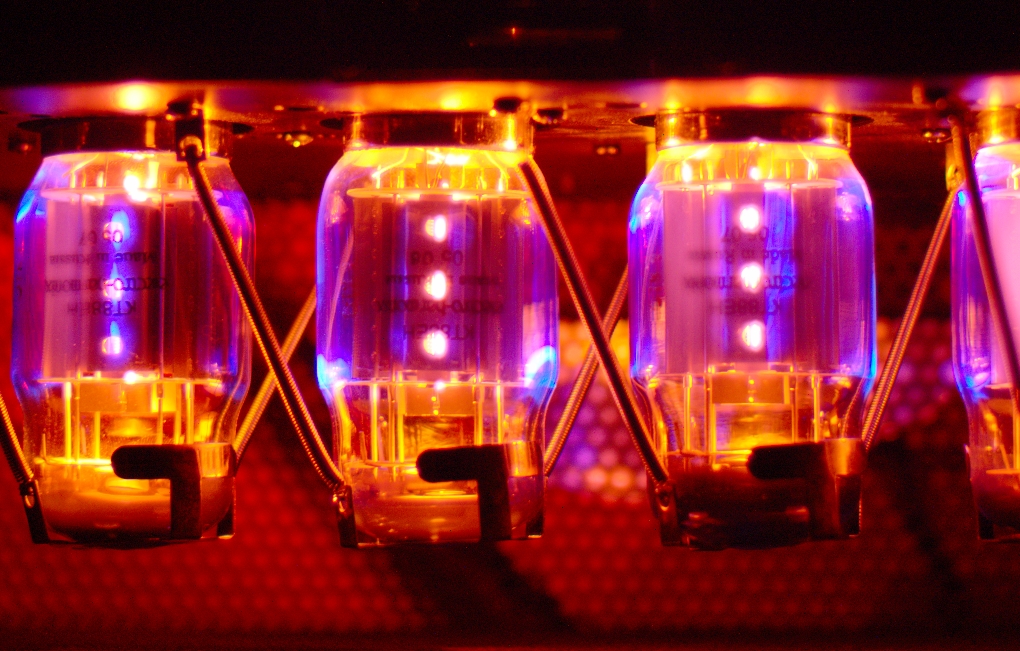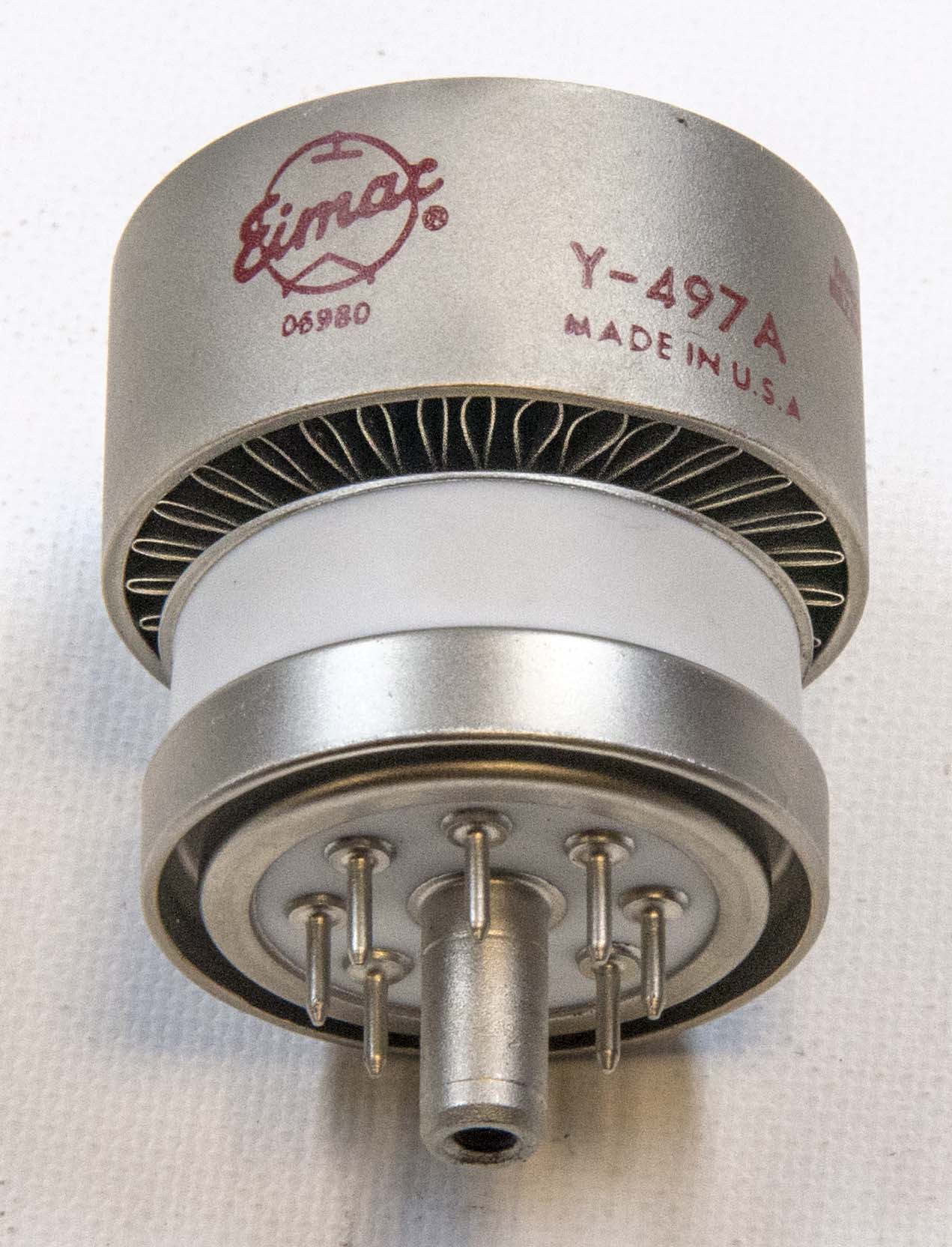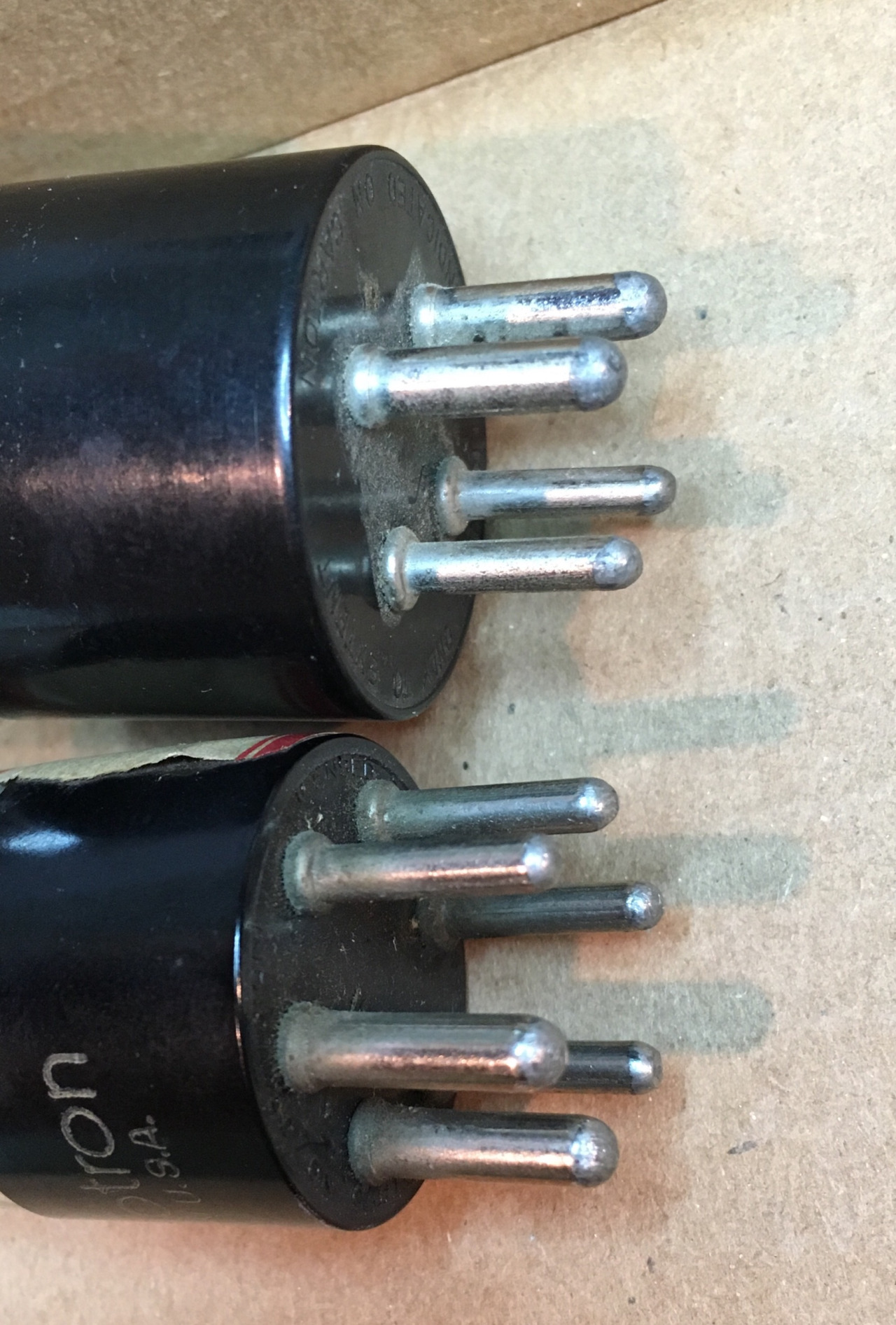|
KT88
The KT88 is a beam tetrode/kinkless tetrode (hence "KT") vacuum tube for audio amplification. Features The KT88 fits a standard eight-pin octal socket and has similar pinout and applications as the 6L6 and EL34. Specifically designed for audio amplification, the KT88 has higher plate power and voltage ratings than the American 6550. It is one of the largest tubes in its class and can handle significantly higher plate voltages than similar tubes, up to 800 volts. A KT88 push-pull pair in class AB1 fixed bias is capable of 100 watts of output with 2.5% total harmonic distortion or up to about 50W at low distortion in hi-fi applications. The transmitting tubes TT21 and TT22 have almost identical transfer characteristics to KT88 but a different pinout, and by virtue of their anode being connected to the top cap have a higher plate voltage rating (1.25 kilovolt) and a higher power output capability of 200 watts in class AB1 push–pull. The screen grid is sometimes tied to the an ... [...More Info...] [...Related Items...] OR: [Wikipedia] [Google] [Baidu] |
Kt88 Power Tubes In Traynor Yba200 Amplifier
The KT88 is a beam tetrode/kinkless tetrode (hence "KT") vacuum tube for audio amplification. Features The KT88 fits a standard eight-pin octal socket and has similar pinout and applications as the 6L6 and EL34. Specifically designed for audio amplification, the KT88 has higher plate power and voltage ratings than the American 6550. It is one of the largest tubes in its class and can handle significantly higher plate voltages than similar tubes, up to 800 volts. A KT88 push-pull pair in class AB1 fixed bias is capable of 100 watts of output with 2.5% total harmonic distortion or up to about 50W at low distortion in hi-fi applications. The transmitting tubes TT21 and TT22 have almost identical transfer characteristics to KT88 but a different pinout, and by virtue of their anode being connected to the top cap have a higher plate voltage rating (1.25 kilovolt) and a higher power output capability of 200 watts in class AB1 push–pull. The screen grid is sometimes tied to the ... [...More Info...] [...Related Items...] OR: [Wikipedia] [Google] [Baidu] |
6550
Tung-Sol was an American manufacturer of electronics, mainly lamps and vacuum tubes. History Tung-Sol was founded as Tung-Sol Lamp Works Inc. in Newark, New Jersey in 1907. Their early products were mainly geared towards the automotive market and included headlamps, pilot lights, and flashlight bulbs. The trade name was formed from the first syllable of "tungsten" and the Latin word "sol" meaning sun. The company entered the electronics field in the 1920s. In time they established themselves as leaders in the development and production of vacuum tubes, with their main competition including RCA and Sylvania. By 1951, they began doing business as Tung-Sol Electric Inc. Soon after, they were acquired by Wagner Electric, which itself merged into Studebaker-Worthington in 1967. Tung-Sol was also active in the semiconductor industry, with its transistors being easily recognizable by their sky blue color. Tung-Sol was privately held and run like a laboratory. This gave Tung-So ... [...More Info...] [...Related Items...] OR: [Wikipedia] [Google] [Baidu] |
EL34
The EL34 is a thermionic vacuum tube of the power pentode type. The EL34 was introduced in 1955 by Mullard, who were owned by Philips. The EL34 has an octal base (indicated by the '3' in the part number) and is found mainly in the final output stages of audio amplification circuits; it was also designed to be suitable as a series regulator by virtue of its high permissible voltage between heater and cathode and other parameters. The American RETMA tube designation number for this tube is 6CA7. The USSR analog was 6P27S (Cyrillic: 6П27C). Specifications In common with all 'E' prefix tubes, using the Mullard–Philips tube designation, the EL34 has a heater voltage of 6.3 V. According to the data sheets found in old vacuum tube reference manuals, a pair of EL34s with 800 V plate voltage can produce 90 watts output in class AB1 in push–pull configuration. However, this configuration is rarely found. One application of this type was in "Australian Sound" public address amplifie ... [...More Info...] [...Related Items...] OR: [Wikipedia] [Google] [Baidu] |
KT66
KT66 is the designator for a beam power tube introduced by Marconi-Osram Valve Co. Ltd. (M-OV) of Britain in 1937 and marketed for application as a power amplifier for audio frequencies and driver for radio frequencies.Editors "The New Valves" ''Wireless World'', August 20th 1937, p. 178General Electric Co., Ltd."Osram Valves" ''Television and Short-Wave World'', Sept. 1939, p. 524 The KT66 is a beam tetrode that utilizes partially collimated electron beams to form a low potential space charge region between the anode and screen grid to return anode secondary emission electrons to the anode and offers significant performance improvements over comparable power pentodes.Dreyer, J. F. Jr."The Beam Power Output Tube" ''Electronics'', Vol. 9, No. 4, April 1936, pp. 18 - 21, 35 In the 21st century, the KT66 is manufactured and used in some high fidelity audio amplifiers and musical instrument amplifiers. Overview Although the RCA 6L6 of 1936 (the result of a license agreement between ... [...More Info...] [...Related Items...] OR: [Wikipedia] [Google] [Baidu] |
Electro-Harmonix
Electro-Harmonix (also commonly referred to as EHX) is a New York City-based company that makes electronic audio processors and sells rebranded vacuum tubes. The company was founded by Mike Matthews in 1968. It is best known for a series of guitar effects pedals introduced in the 1970s and 1990s. EHX also made a line of guitars in the 1970s. During the mid-1970s, Electro-Harmonix established itself as a manufacturer of guitar effects pedals. It was the first company to manufacture, and market affordable state-of-the art "stomp-boxes" for guitarist and bassists, such as the first stomp-box flanger (Electric Mistress), the first analog echo/delay unit with no moving parts (Memory Man), the first guitar synthesizer in pedal form (Micro Synthesizer), and the first tube-amp distortion simulator (Hot Tubes). In 1980, Electro-Harmonix also designed and marketed one of the first digital delay/looper pedals (16-Second Digital Delay) and a line of guitars in the 1970s. Company histor ... [...More Info...] [...Related Items...] OR: [Wikipedia] [Google] [Baidu] |
Beam Tetrode
A beam tetrode, sometimes called a beam power tube, is a type of vacuum tube or thermionic valve that has two grids and forms the electron stream from the cathode into multiple partially collimated beams to produce a low potential space charge region between the anode and screen grid to return anode secondary emission electrons to the anode when the anode potential is less than that of the screen grid.Winfield G. Wagener, (May 1948"500-Mc. Transmitting Tetrode Design Considerations" ''Proceedings of the I.R.E.'', p. 612. Retrieved 10 June 2021 Beam tetrodes are usually used for power amplification, from audio frequency to radio frequency. The beam tetrode produces greater output power than a triode or pentode with the same anode supply voltage. The first beam tetrode marketed was the Marconi N40, introduced in 1935.Editors, (Feb. 1935"New Output Tetrode" ''Electronics'', vol. 8 no.2, p. 65. Retrieved 10 June 2021K. R. Thrower, (2009) ''British Radio Valves The Classic Year ... [...More Info...] [...Related Items...] OR: [Wikipedia] [Google] [Baidu] |
Tube Socket
Tube sockets are electrical sockets into which vacuum tubes (electronic valves) can be plugged, holding them in place and providing terminals, which can be soldered into the circuit, for each of the pins. Sockets are designed to allow tubes to be inserted in only one orientation. They were used in most tube electronic equipment to allow easy removal and replacement. When tube equipment was common, retailers such as drug stores had vacuum tube testers, and sold replacement tubes. Some Nixie tubes were also designed to use sockets. Throughout the tube era, as technology developed, sometimes differently in different parts of the world, many tube bases and sockets came into use. Sockets are not universal; different tubes may fit mechanically into the same socket, though they may not work properly and possibly become damaged. Tube sockets were typically mounted in holes on a sheet metal chassis and wires or other components were hand soldered to lugs on the underside of the socket. ... [...More Info...] [...Related Items...] OR: [Wikipedia] [Google] [Baidu] |
JJ Electronic
JJ Electronic, s.r.o is a Slovak electronic component manufacturer, and one of the world's remaining producers of vacuum tubes. It is based in Čadca, in the Kysuce region of Slovakia. Most of its products are audio receiving tubes, mainly used for guitar and hi-fi amplifiers. In technical terms, JJ produces triodes, beam tetrodes and power pentodes. Double diode vacuum tubes for full wave AC-to-DC rectifiers are also produced. JJ also produces electrolytic capacitors for higher-voltage purposes, generally for use in audio amplifiers. JJ also manufactures its own line of high-end audio amplifiers and guitar amplifiers. In 2015, the company sales amounted to EUR 8.5 million and net income came to EUR 3.8 million. Most production is exported to the United States. History Before 1989, Tesla was the main Czechoslovak producer of electron tubes. While Tesla vacuum tubes were exported all over the world, and were known for their quality, the company did not survive the change of ... [...More Info...] [...Related Items...] OR: [Wikipedia] [Google] [Baidu] |
Vacuum Tube
A vacuum tube, electron tube, valve (British usage), or tube (North America), is a device that controls electric current flow in a high vacuum between electrodes to which an electric potential difference has been applied. The type known as a thermionic tube or thermionic valve utilizes thermionic emission of electrons from a hot cathode for fundamental electronic functions such as signal amplification and current rectification. Non-thermionic types such as a vacuum phototube, however, achieve electron emission through the photoelectric effect, and are used for such purposes as the detection of light intensities. In both types, the electrons are accelerated from the cathode to the anode by the electric field in the tube. The simplest vacuum tube, the diode (i.e. Fleming valve), invented in 1904 by John Ambrose Fleming, contains only a heated electron-emitting cathode and an anode. Electrons can only flow in one direction through the device—from the cathode to the ... [...More Info...] [...Related Items...] OR: [Wikipedia] [Google] [Baidu] |
Triode
A triode is an electronic amplifying vacuum tube (or ''valve'' in British English) consisting of three electrodes inside an evacuated glass envelope: a heated filament or cathode, a grid, and a plate (anode). Developed from Lee De Forest's 1906 Audion, a partial vacuum tube that added a grid electrode to the thermionic diode ( Fleming valve), the triode was the first practical electronic amplifier and the ancestor of other types of vacuum tubes such as the tetrode and pentode. Its invention founded the electronics age, making possible amplified radio technology and long-distance telephony. Triodes were widely used in consumer electronics devices such as radios and televisions until the 1970s, when transistors replaced them. Today, their main remaining use is in high-power RF amplifiers in radio transmitters and industrial RF heating devices. In recent years there has been a resurgence in demand for low power triodes due to renewed interest in tube-type audio systems b ... [...More Info...] [...Related Items...] OR: [Wikipedia] [Google] [Baidu] |
Changsha Hengyang Electronics Company
Changsha (; ; ; Changshanese pronunciation: (), Standard Mandarin pronunciation: ) is the capital and the largest city of Hunan Province of China. Changsha is the 17th most populous city in China with a population of over 10 million, and the third-most populous city in Central China, located in the lower reaches of Xiang River in northeastern Hunan. Changsha is also called Xingcheng (星城, 'Star City') and was once named Linxiang (临湘), Tanzhou (潭州), Qingyang (青阳) in ancient times. It is also known as Shanshuizhoucheng (山水洲城), with the Xiang River flowing through it, containing Mount Yuelu and Orange Isle. The city forms a part of the Greater Changsha Metropolitan Region along with Zhuzhou and Xiangtan, also known as Changzhutan City Cluster. Greater Changsha was named as one of the 13 emerging mega-cities in China in 2012 by the Economist Intelligence Unit. It is also a National Comprehensive Transportation Hub, and one of the first National Famo ... [...More Info...] [...Related Items...] OR: [Wikipedia] [Google] [Baidu] |









